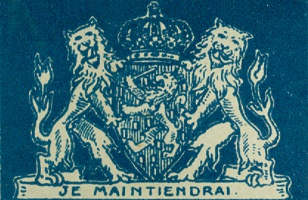 |
Usually January
is a slow month, in selling and therefore in buying too. But we spent our funds
well and at the end there were plenty of decks to choose from. |
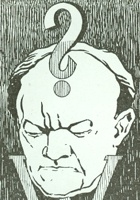 |
January 2018
 |
Usually January
is a slow month, in selling and therefore in buying too. But we spent our funds
well and at the end there were plenty of decks to choose from. |
 |
This month we did some good buys on eBay and at the Dutch collectors meeting in Kerkdriel. Also two Kickstarter projects came through, each with 2 different decks. Plenty of decks always make it a hard choice. Do we go for modern and innovative or for antique and rare? Well, in the modern part of the shortlist there was a rare East German deck commemorating the opening of the stage play of My Fair Lady in Karl-Marx-Stadt in 1967, the limited edition of the NEO playing cards from 2017 and let's not forget the wonderful, surrealistic Swiss patterned deck by Benedikt Notter from 2015. The latter was such a striking deck, that we've decided to give that deck a spot in the ART & CARDS section of this site. In the antique part of the short list there was not much going on until the last Saturday of the month. A visit to a young couple, who had found playing cards in their grandparents attic and had contacted us to see if we were interested, brought 5 new decks for our collection. Among them were a Dutch SN Export deck from the 1920's (but in a wrapper that we didn't have yet) and a deck by Johann Müller from Frankfurt, Germany active in the early 1870's. The pattern is the same as in our Deck of the Month of January 2011. Our new found deck is a version with plain aces, but.... it's complete and in very good condition. And let's not forget to thank Rhonda Hawes for intermediating in a buy on eBay from a seller who wouldn't ship outside the US. Her package arrived on the 30th and brought us an improvement of the coloured HCA deck. Our pack missed one joker and came in a plastic box, but now we have a complete deck with 2 jokers, a blank card and the original box. HCA??? Click and see!
The first choice was to go with antique again this month and the final one to go for a Belgian deck, with a pattern that wasn't in our Belgian collection yet.
Published
as "Cartes
Allemandes" (German cards) by Brepols & Dierckx zoon from Turnhout, Belgium,
1890's.
Stencil coloured (rather crudely) on cheap card, probably made for daily -but
short lasting- use.
 |
|
|
| The Queens are all holding a fan. These fans were very popular among the ladies at the courts during the last decades of the 19th century. The Dutch Queen Wilhelmina was a collector | ||
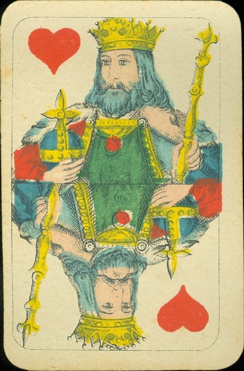 |
|
|
|
Sometimes Belgian makers name the decks after the
used aces (e.g "Cartes Suisses" or "Cartes Hollandaises"), |
|||
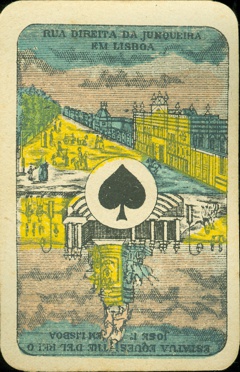 |
|
|
|
|
And indeed the pattern has a striking resemblance with a pattern that was used by the Vereinigte Stralsunder Spielkartenfabriken from Stralsund, Germany, around 1890 too. We have a deck to compare, that also came with a set of Portuguese aces. It was our Deck of the Month in January 2009. When compared, the images are the same in each suit, except that the JD and JH have changed places in this deck here. The Portuguese scenes on the aces are the same, but the VSS images are finer in design and print. The quality of the design and colouring of the courts are higher too. |
|||
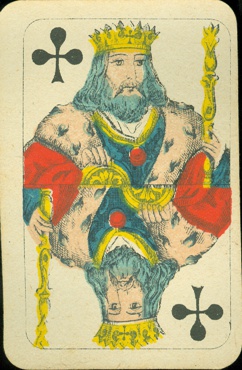 |
|
|
|
I've often wondered why Belgian manufacturers hardly ever print their name or logo on one of the cards. It would make life much easier for collectors. Not always, but German manufacturers are usually easier to identify by a name or logo. The German deck has the logo of the Vereinigte Stralsunder Spielkartenfabriken on the QC. In the old days copyrights weren't as respected or protected as they are nowadays. So when a certain pattern was introduced by a maker in a certain country, a manufacturer in an other country would publish a similar pattern, hoping that it would become popular. I guess this pattern didn't do much for the Belgians, as it's not often seen. |
||
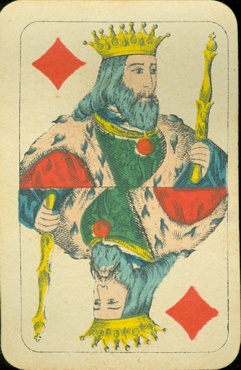 |
|
|
The deck has 52 cards. No joker was issued and it came without box or wrapper.
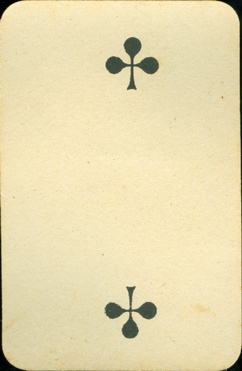
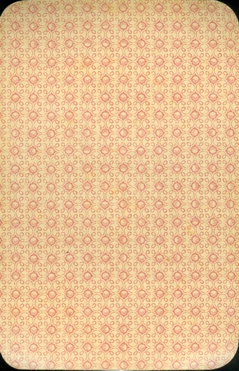
|
|
||
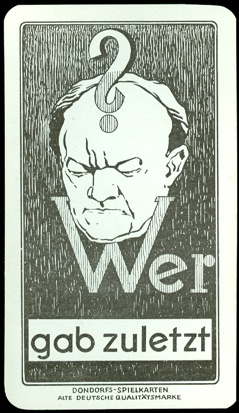 |
CARD OF THE MONTH Every once
in a while we come across a single card that catches our eye. This month
it was a card that was printed by the Dondorf company. It's a single card
that can be added to the cards when playing a game. Judging by the size of
the card that game will probably have to be played with German suited cards from a
German regional pattern. |
|
|
|
||
|
ITEM OF THE MONTH |
||
|
Just like the card above, this will not be
a regular feature on these pages, but perhaps every once in a while
we'll present an "Item of the Month". This is the first in
many years and the reason that we - especially Joop- got so excited
about it, lies in the fact that there is very little known about this
Dutch manufacturer and only 4 different types of decks have ever been found. We
have one in our collection and based on the depicted cards on this still
closed wrapper, we believe that it will hold the deck that we have. So
if you click on the logo here below in the center, you'll see the
content. |
||
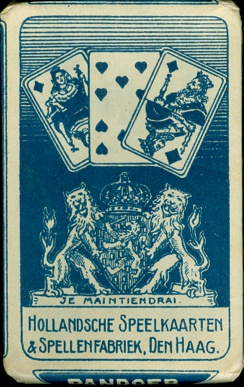 |
|
 |